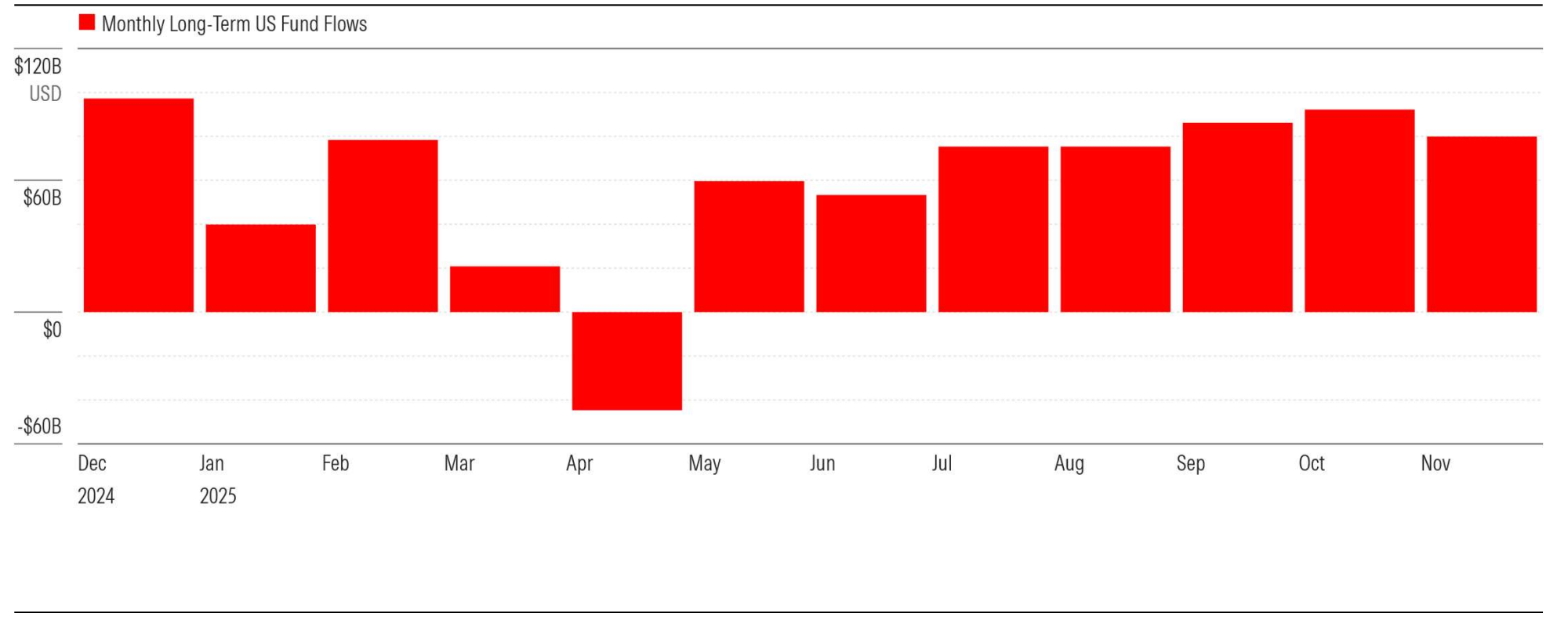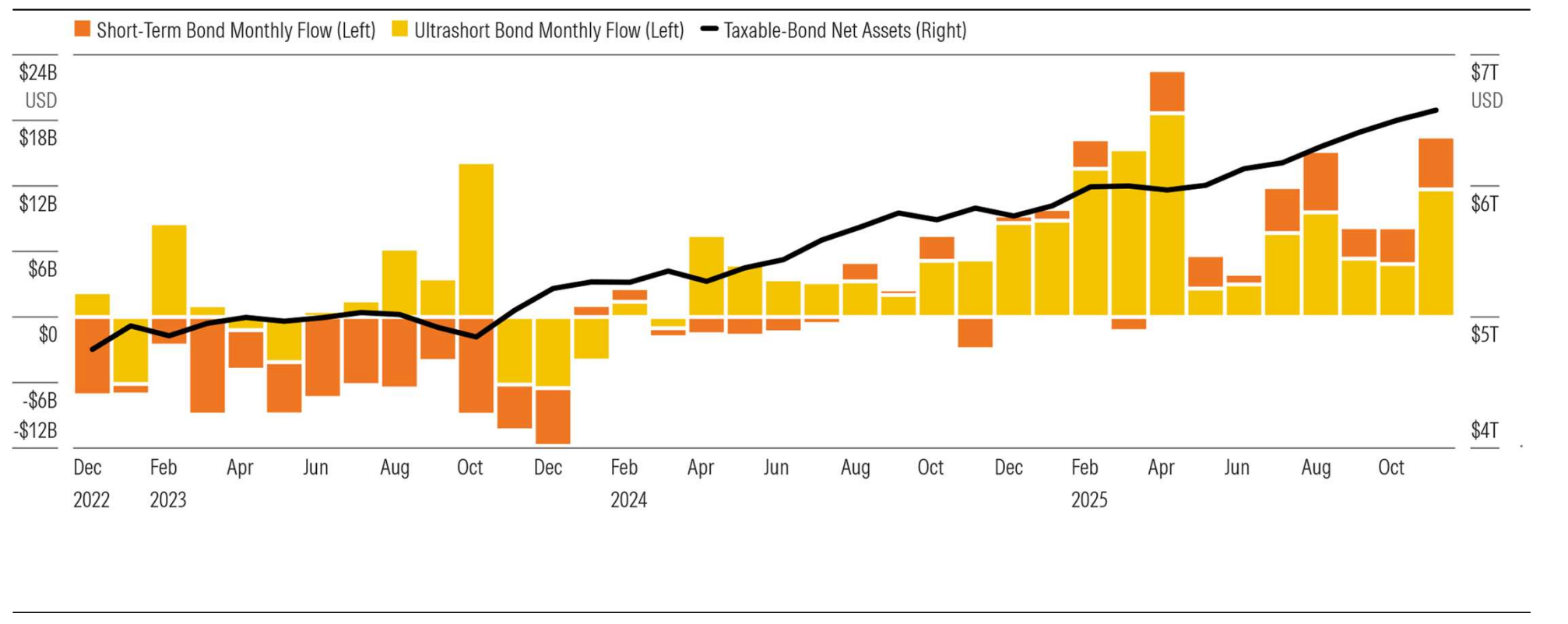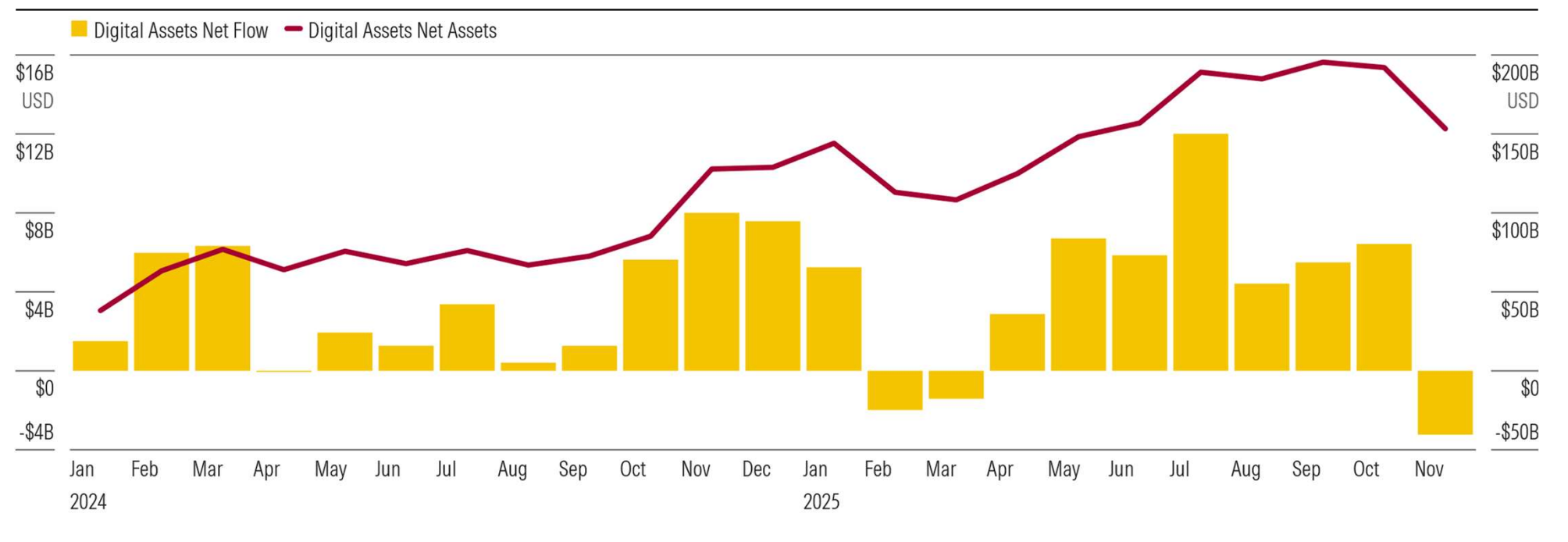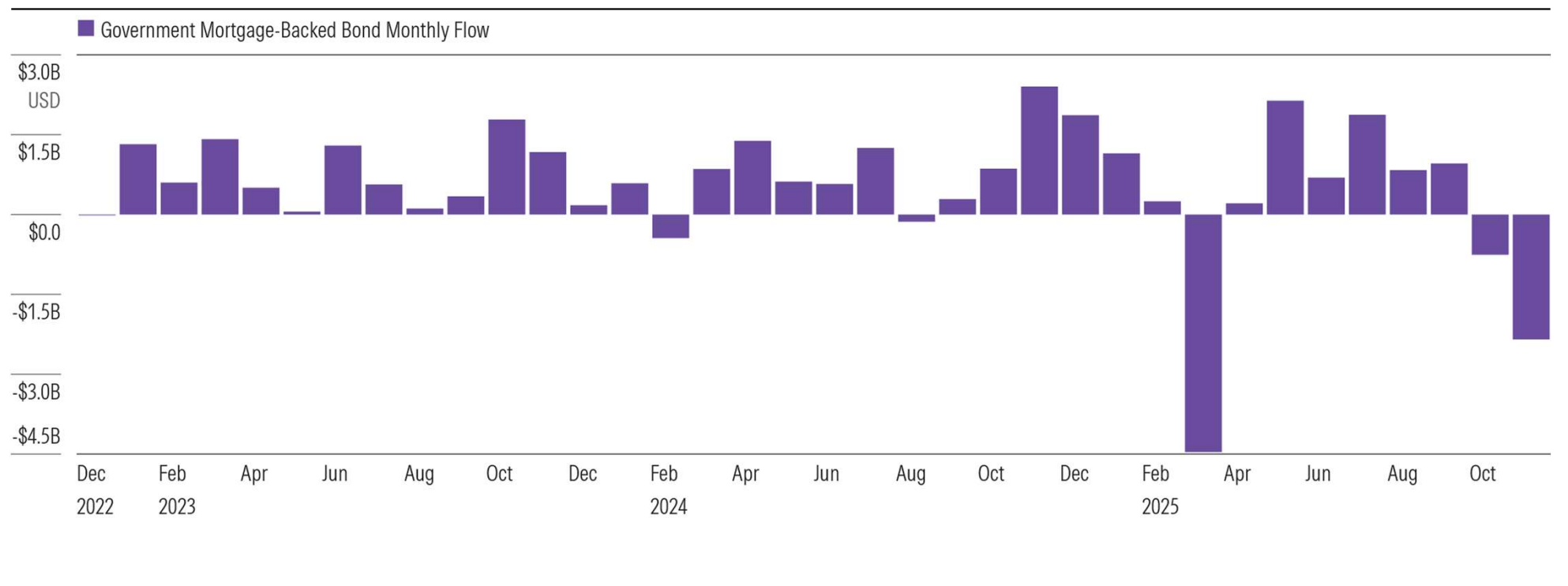5 min read
US Fund Flows: November Flows Reflect Cautious Confidence

Key Takeaways
Investors poured nearly $80 billion into long-term US mutual funds and exchange-traded funds in November 2025, the seventh straight month of inflows.
US equity funds bucked a six-month streak of outflows with a minor inflow of $3 billion. Durable trends persisted, with large-blend funds driving inflows, particularly from passive investors, while growth categories led outflows.
Taxable-bond funds continued to claim the largest share of inflows amid a rate-cutting cycle, bringing in another $51 billion. Shorter-maturity Morningstar Categories, like ultrashort bond and short-term bond, took in about a third of these inflows. Credit-sensitive categories, like high-yield bonds, bank loans, and preferred stock, shed assets.
On this page
On this page
On this page
On this page
Long-term US fund flows notched their seventh straight month of inflows in November, collectively raking in a net $80 billion. In a volatile month, investors appeared affected by rate-cutting expectations, as well as uncertainty around the artificial intelligence stock trade.
Consistent with the past several months, flows favored taxable bonds, especially lower-risk areas within it, as well as international stocks over US equities. That said, US equity funds broke a six-month streak of outflows, tech sector funds posted their first outflow since April, and crypto assets lost some allure.
The charts below illustrate which direction the money is flowing for a variety of fund types. For a more complete analysis, download the full monthly report.
This data was sourced from Morningstar Direct. Not a user? Get a free trial of Direct.

Source: Morningstar Direct Asset Flows. Data as of Nov. 30, 2025.
Navigating Market Volatility Through Fund Flows Data
US Equity Funds’ November Inflow Breaks 6-Month Streak
US equity funds gathered a scant $3.4 billion in November, good enough to reverse a six-month outflow streak. Yet, durable category trends persisted; large-blend funds’ $18 billion inflow led categories within the group, with the three largest outflows going to the growth categories. Passive inflows dominated, especially to large-blend stalwarts.
However, investors also gave thanks for large value, blessing the category with nearly $3 billion in inflows, with the iShares S&P 500 Value ETF experiencing its largest inflow on record, at $4 billion, and a monthly organic growth rate of nearly 10%.

Source: Morningstar Direct Asset Flows. Data as of Nov. 30, 2025. OGR stands for organic growth rate.
Taxable-Bond Funds Remain in the Driver’s Seat
Taxable-bond funds continued to rake in assets in November, with 22 of 27 categories gathering assets amid a rate-cutting cycle. Their $51 billion inflow marked the seventh consecutive month of inflows exceeding $50 billion. In the past three years, total net assets in taxable-bond funds increased 38%.
Much of that growth in 2025 was attributable to less-risky categories such as intermediate-core bond, ultrashort bond, and short-term bond. Investors favored shorter bonds in November as the US yield curve continued to steepen, as persistent long-term inflation concerns remained.

Source: Morningstar Direct Asset Flows. Data as of Nov. 30, 2025.
Crypto Takes a Dive in November
Digital assets funds did not fare well in November, notching their largest monthly outflow on record of $3.2 billion. While this absolute value was surely affected by crypto’s exponential growth in recent years, November's organic growth rate of negative 1.7% was its lowest on record as well.
Bitcoin and Ethereum funds dominate the digital assets category, and in November, these two lost approximately 17% and 21% of their values, respectively. Considering both outflows and crypto price drops, the digital assets category shrank by over 20%, down to $153 billion.

Source: Morningstar Direct Asset Flows. Data as of Nov. 30, 2025.
Rate-Cut Sentiment Pushed Investors Out of Some Bond Categories
Not all categories benefited alike in November from expectations of a December rate cut. Government mortgage-backed bond funds lost $2.3 billion, their second-largest outflow in the past five years, as falling rates come with increased prepayment risks in mortgages.
Credit-sensitive categories, such as high-yield bonds and bank loans, which generally don’t benefit as much when rates decline relative to other areas of fixed income, also experienced modest outflows in November.

Source: Morningstar Direct Asset Flows. Data as of Nov. 30, 2025.
More on Fund Flows from Morningstar
For more comprehensive analysis and commentary on US Fund Flows, download this month’s full report.
- Flows for the largest fund families
- Morningstar categories with the lowest and highest fund flows
- Government bond fund and money market flows
Morningstar’s asset fund flows history dates to 2008, with forecasting models for future growth rates. The Morningstar Direct application includes all fund flows data along with its performance reporting, presentation, and search capabilities. The Direct team also supports new users with onboarding, training materials, and 24-hour customer service.
Start a free trial of Morningstar Direct and evaluate fund flow data your way.
Note: The figures in this report were compiled on Sept. 30, 2025, and reflect only the funds that had reported net assets by that date. The figures in both the commentary and the extended tables are survivorship-bias-free. This report includes both mutual funds and exchange-traded funds but not funds of funds unless specifically stated. It does not include collective investment trusts or separate accounts. Important methodology note: Morningstar computes flows using the standard approach in the industry: Net flow is the estimated change in assets not explained by the performance of the fund. Our method assumes that flows occur uniformly over the course of the month. Adjustments for mergers are performed automatically. When liquidated funds are included, the fund's final assets are counted as outflows. Reinvested dividends are not counted as inflows. We use fund-level reinvestment rates to improve accuracy in this respect. We make ad hoc adjustments for unusual corporate actions such as reverse share splits, and we overwrite our estimates with actual flows if managers are willing to provide the data to us. When possible, Morningstar offsets outflows caused by transfers to other investment vehicles that share an identical mandate since they are not indicative of a change in investor interest.


